WORK5003: Organizational Shift - Culture and Managerial Control
VerifiedAdded on 2023/06/12
|13
|3736
|84
Essay
AI Summary
This essay examines the purported fundamental shift in organizational structures from vertical bureaucracies to horizontal corporations, as argued by Manuel Castells. It explores whether traditional principles of bureaucracy and hierarchy remain relevant in contemporary organizations. The essay further discusses the implications of this shift, real or perceived, on organizational culture, particularly its role as a social glue for integration, and on managerial control systems, focusing on ensuring consistent work performance. The analysis incorporates Castells' perspective on the impact of technology and globalization on organizational structures, highlighting the rise of networked organizations and the changing nature of work. It also touches upon the cultural implications, emphasizing the importance of IT, social media, and collaborative network management in shaping organizational dynamics. The essay concludes by addressing the challenges and adaptations required for organizations to thrive in the evolving landscape.
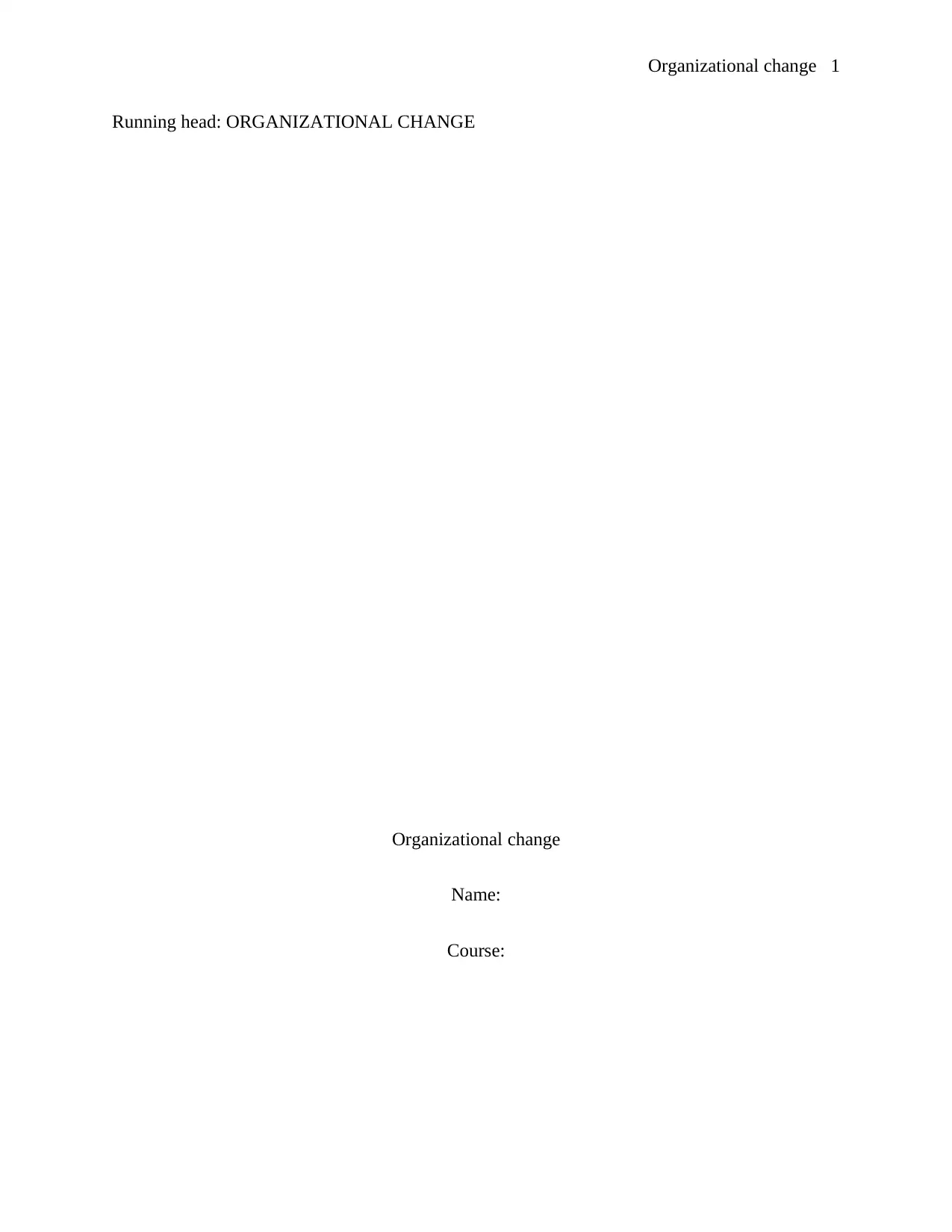
1Organizational change
Running head: ORGANIZATIONAL CHANGE
Organizational change
Name:
Course:
Running head: ORGANIZATIONAL CHANGE
Organizational change
Name:
Course:
Paraphrase This Document
Need a fresh take? Get an instant paraphrase of this document with our AI Paraphraser
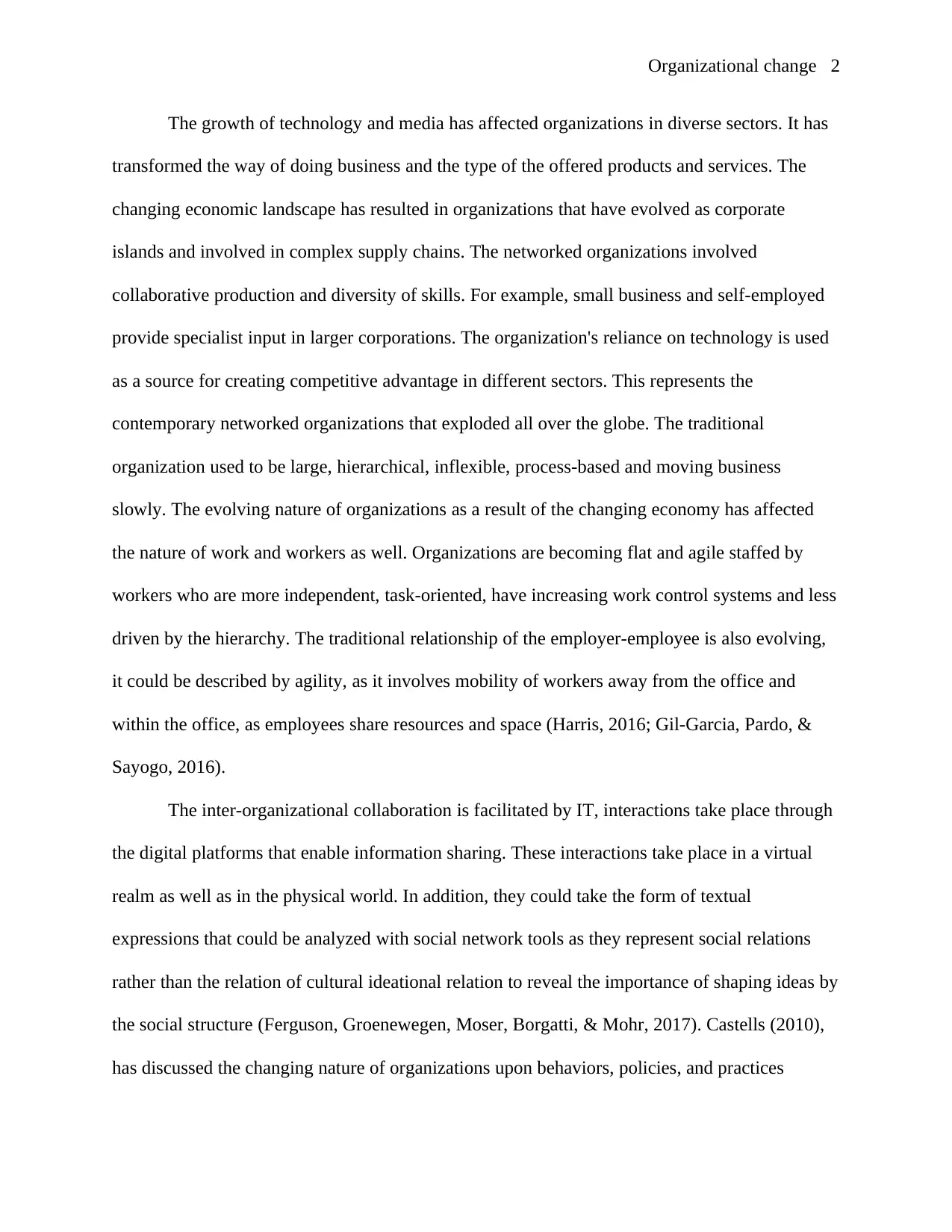
2Organizational change
The growth of technology and media has affected organizations in diverse sectors. It has
transformed the way of doing business and the type of the offered products and services. The
changing economic landscape has resulted in organizations that have evolved as corporate
islands and involved in complex supply chains. The networked organizations involved
collaborative production and diversity of skills. For example, small business and self-employed
provide specialist input in larger corporations. The organization's reliance on technology is used
as a source for creating competitive advantage in different sectors. This represents the
contemporary networked organizations that exploded all over the globe. The traditional
organization used to be large, hierarchical, inflexible, process-based and moving business
slowly. The evolving nature of organizations as a result of the changing economy has affected
the nature of work and workers as well. Organizations are becoming flat and agile staffed by
workers who are more independent, task-oriented, have increasing work control systems and less
driven by the hierarchy. The traditional relationship of the employer-employee is also evolving,
it could be described by agility, as it involves mobility of workers away from the office and
within the office, as employees share resources and space (Harris, 2016; Gil-Garcia, Pardo, &
Sayogo, 2016).
The inter-organizational collaboration is facilitated by IT, interactions take place through
the digital platforms that enable information sharing. These interactions take place in a virtual
realm as well as in the physical world. In addition, they could take the form of textual
expressions that could be analyzed with social network tools as they represent social relations
rather than the relation of cultural ideational relation to reveal the importance of shaping ideas by
the social structure (Ferguson, Groenewegen, Moser, Borgatti, & Mohr, 2017). Castells (2010),
has discussed the changing nature of organizations upon behaviors, policies, and practices
The growth of technology and media has affected organizations in diverse sectors. It has
transformed the way of doing business and the type of the offered products and services. The
changing economic landscape has resulted in organizations that have evolved as corporate
islands and involved in complex supply chains. The networked organizations involved
collaborative production and diversity of skills. For example, small business and self-employed
provide specialist input in larger corporations. The organization's reliance on technology is used
as a source for creating competitive advantage in different sectors. This represents the
contemporary networked organizations that exploded all over the globe. The traditional
organization used to be large, hierarchical, inflexible, process-based and moving business
slowly. The evolving nature of organizations as a result of the changing economy has affected
the nature of work and workers as well. Organizations are becoming flat and agile staffed by
workers who are more independent, task-oriented, have increasing work control systems and less
driven by the hierarchy. The traditional relationship of the employer-employee is also evolving,
it could be described by agility, as it involves mobility of workers away from the office and
within the office, as employees share resources and space (Harris, 2016; Gil-Garcia, Pardo, &
Sayogo, 2016).
The inter-organizational collaboration is facilitated by IT, interactions take place through
the digital platforms that enable information sharing. These interactions take place in a virtual
realm as well as in the physical world. In addition, they could take the form of textual
expressions that could be analyzed with social network tools as they represent social relations
rather than the relation of cultural ideational relation to reveal the importance of shaping ideas by
the social structure (Ferguson, Groenewegen, Moser, Borgatti, & Mohr, 2017). Castells (2010),
has discussed the changing nature of organizations upon behaviors, policies, and practices
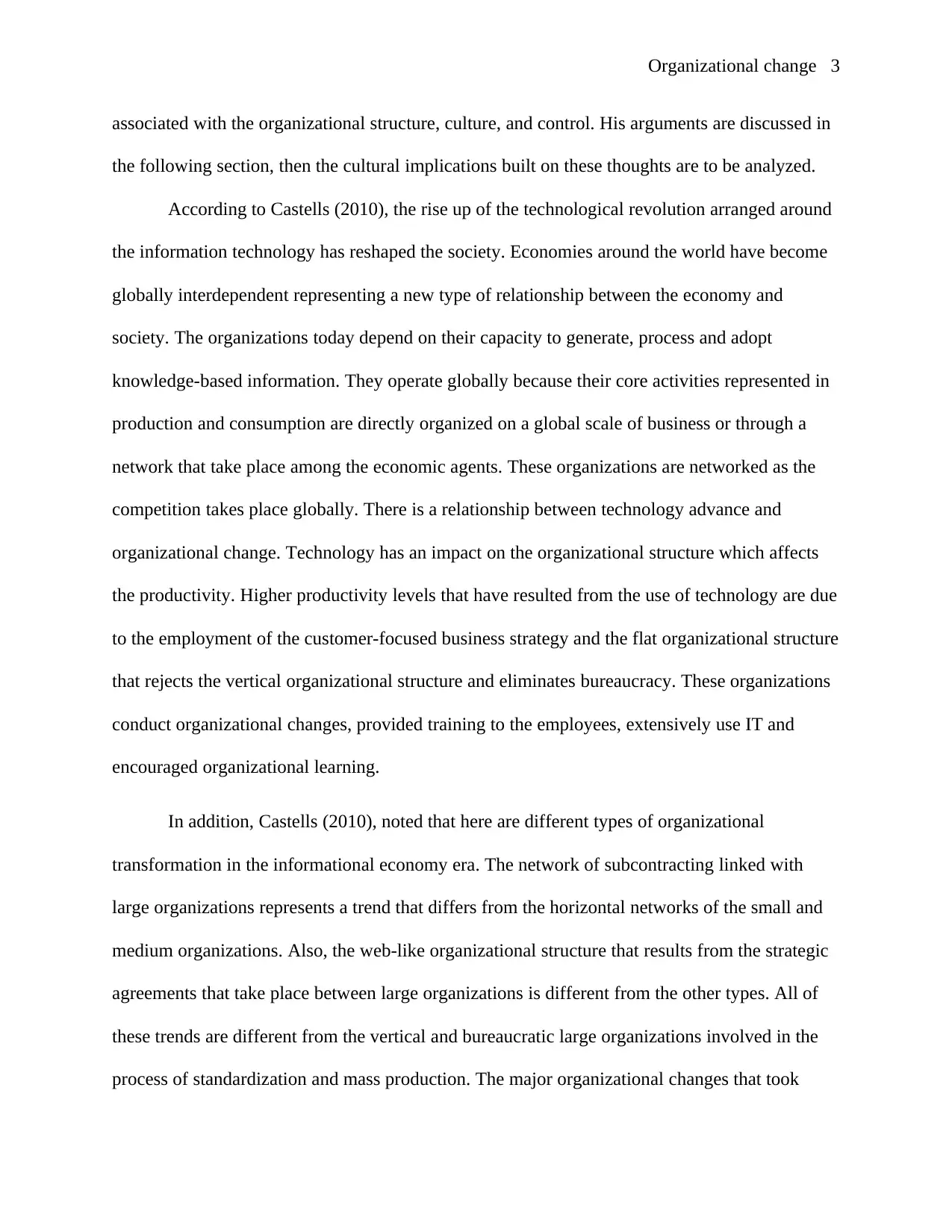
3Organizational change
associated with the organizational structure, culture, and control. His arguments are discussed in
the following section, then the cultural implications built on these thoughts are to be analyzed.
According to Castells (2010), the rise up of the technological revolution arranged around
the information technology has reshaped the society. Economies around the world have become
globally interdependent representing a new type of relationship between the economy and
society. The organizations today depend on their capacity to generate, process and adopt
knowledge-based information. They operate globally because their core activities represented in
production and consumption are directly organized on a global scale of business or through a
network that take place among the economic agents. These organizations are networked as the
competition takes place globally. There is a relationship between technology advance and
organizational change. Technology has an impact on the organizational structure which affects
the productivity. Higher productivity levels that have resulted from the use of technology are due
to the employment of the customer-focused business strategy and the flat organizational structure
that rejects the vertical organizational structure and eliminates bureaucracy. These organizations
conduct organizational changes, provided training to the employees, extensively use IT and
encouraged organizational learning.
In addition, Castells (2010), noted that here are different types of organizational
transformation in the informational economy era. The network of subcontracting linked with
large organizations represents a trend that differs from the horizontal networks of the small and
medium organizations. Also, the web-like organizational structure that results from the strategic
agreements that take place between large organizations is different from the other types. All of
these trends are different from the vertical and bureaucratic large organizations involved in the
process of standardization and mass production. The major organizational changes that took
associated with the organizational structure, culture, and control. His arguments are discussed in
the following section, then the cultural implications built on these thoughts are to be analyzed.
According to Castells (2010), the rise up of the technological revolution arranged around
the information technology has reshaped the society. Economies around the world have become
globally interdependent representing a new type of relationship between the economy and
society. The organizations today depend on their capacity to generate, process and adopt
knowledge-based information. They operate globally because their core activities represented in
production and consumption are directly organized on a global scale of business or through a
network that take place among the economic agents. These organizations are networked as the
competition takes place globally. There is a relationship between technology advance and
organizational change. Technology has an impact on the organizational structure which affects
the productivity. Higher productivity levels that have resulted from the use of technology are due
to the employment of the customer-focused business strategy and the flat organizational structure
that rejects the vertical organizational structure and eliminates bureaucracy. These organizations
conduct organizational changes, provided training to the employees, extensively use IT and
encouraged organizational learning.
In addition, Castells (2010), noted that here are different types of organizational
transformation in the informational economy era. The network of subcontracting linked with
large organizations represents a trend that differs from the horizontal networks of the small and
medium organizations. Also, the web-like organizational structure that results from the strategic
agreements that take place between large organizations is different from the other types. All of
these trends are different from the vertical and bureaucratic large organizations involved in the
process of standardization and mass production. The major organizational changes that took
⊘ This is a preview!⊘
Do you want full access?
Subscribe today to unlock all pages.

Trusted by 1+ million students worldwide
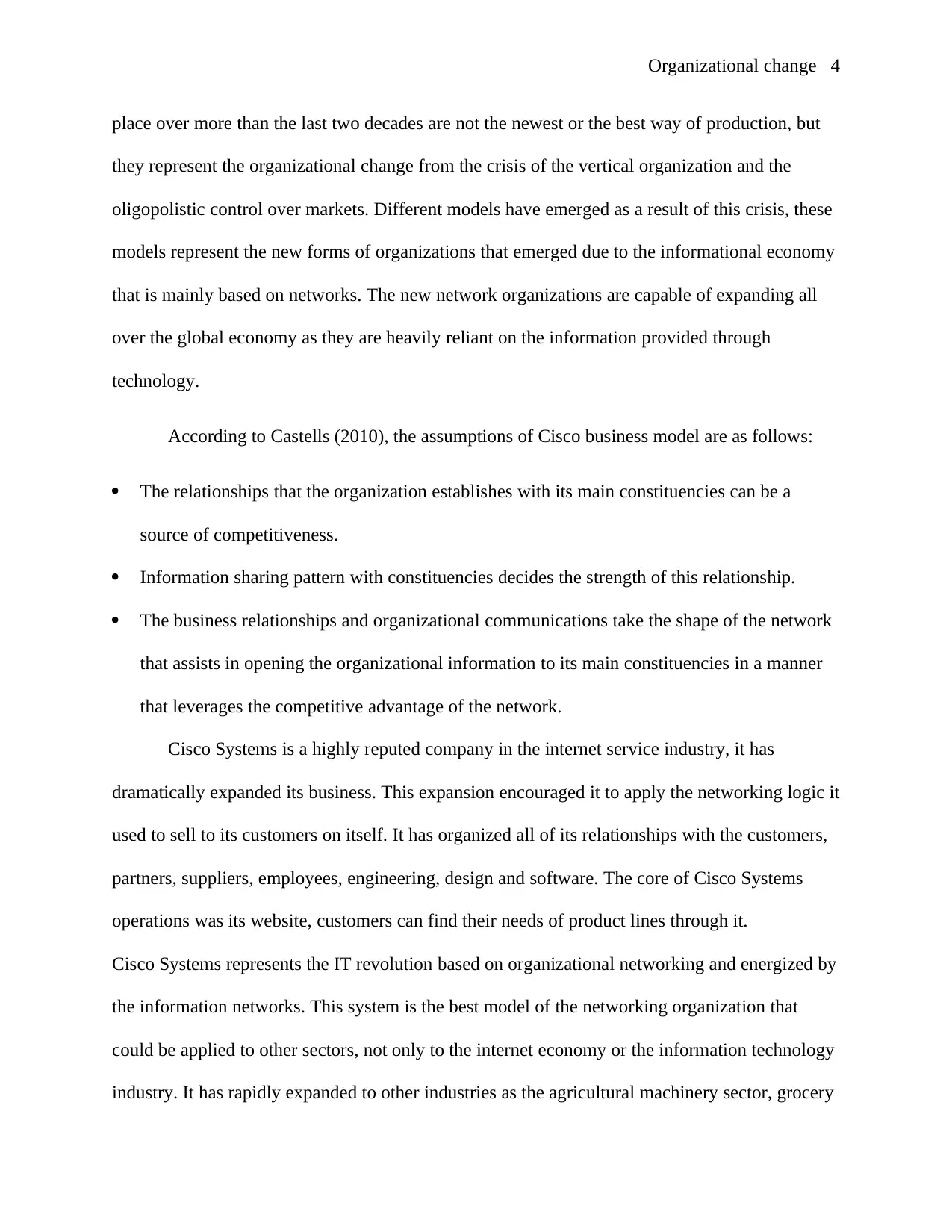
4Organizational change
place over more than the last two decades are not the newest or the best way of production, but
they represent the organizational change from the crisis of the vertical organization and the
oligopolistic control over markets. Different models have emerged as a result of this crisis, these
models represent the new forms of organizations that emerged due to the informational economy
that is mainly based on networks. The new network organizations are capable of expanding all
over the global economy as they are heavily reliant on the information provided through
technology.
According to Castells (2010), the assumptions of Cisco business model are as follows:
The relationships that the organization establishes with its main constituencies can be a
source of competitiveness.
Information sharing pattern with constituencies decides the strength of this relationship.
The business relationships and organizational communications take the shape of the network
that assists in opening the organizational information to its main constituencies in a manner
that leverages the competitive advantage of the network.
Cisco Systems is a highly reputed company in the internet service industry, it has
dramatically expanded its business. This expansion encouraged it to apply the networking logic it
used to sell to its customers on itself. It has organized all of its relationships with the customers,
partners, suppliers, employees, engineering, design and software. The core of Cisco Systems
operations was its website, customers can find their needs of product lines through it.
Cisco Systems represents the IT revolution based on organizational networking and energized by
the information networks. This system is the best model of the networking organization that
could be applied to other sectors, not only to the internet economy or the information technology
industry. It has rapidly expanded to other industries as the agricultural machinery sector, grocery
place over more than the last two decades are not the newest or the best way of production, but
they represent the organizational change from the crisis of the vertical organization and the
oligopolistic control over markets. Different models have emerged as a result of this crisis, these
models represent the new forms of organizations that emerged due to the informational economy
that is mainly based on networks. The new network organizations are capable of expanding all
over the global economy as they are heavily reliant on the information provided through
technology.
According to Castells (2010), the assumptions of Cisco business model are as follows:
The relationships that the organization establishes with its main constituencies can be a
source of competitiveness.
Information sharing pattern with constituencies decides the strength of this relationship.
The business relationships and organizational communications take the shape of the network
that assists in opening the organizational information to its main constituencies in a manner
that leverages the competitive advantage of the network.
Cisco Systems is a highly reputed company in the internet service industry, it has
dramatically expanded its business. This expansion encouraged it to apply the networking logic it
used to sell to its customers on itself. It has organized all of its relationships with the customers,
partners, suppliers, employees, engineering, design and software. The core of Cisco Systems
operations was its website, customers can find their needs of product lines through it.
Cisco Systems represents the IT revolution based on organizational networking and energized by
the information networks. This system is the best model of the networking organization that
could be applied to other sectors, not only to the internet economy or the information technology
industry. It has rapidly expanded to other industries as the agricultural machinery sector, grocery
Paraphrase This Document
Need a fresh take? Get an instant paraphrase of this document with our AI Paraphraser
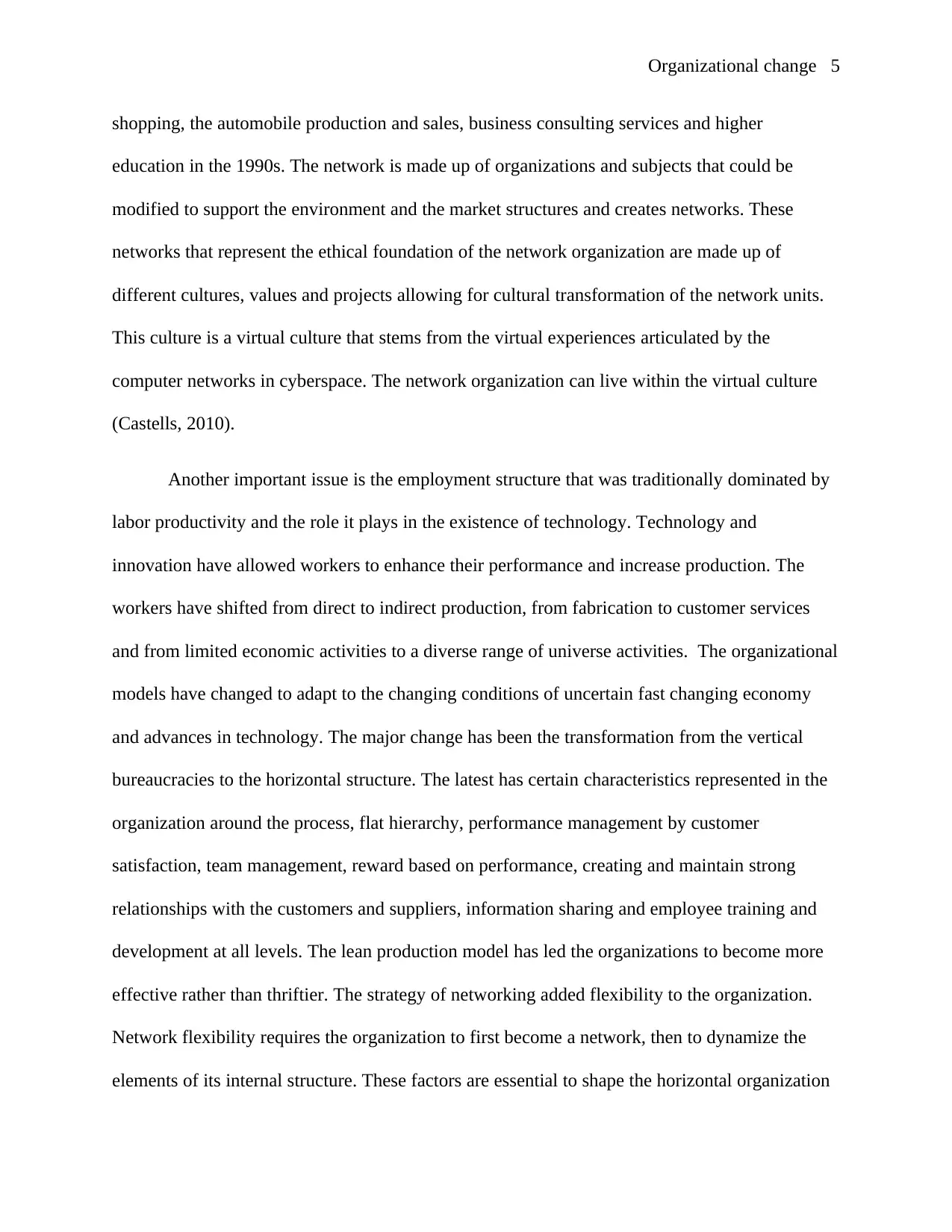
5Organizational change
shopping, the automobile production and sales, business consulting services and higher
education in the 1990s. The network is made up of organizations and subjects that could be
modified to support the environment and the market structures and creates networks. These
networks that represent the ethical foundation of the network organization are made up of
different cultures, values and projects allowing for cultural transformation of the network units.
This culture is a virtual culture that stems from the virtual experiences articulated by the
computer networks in cyberspace. The network organization can live within the virtual culture
(Castells, 2010).
Another important issue is the employment structure that was traditionally dominated by
labor productivity and the role it plays in the existence of technology. Technology and
innovation have allowed workers to enhance their performance and increase production. The
workers have shifted from direct to indirect production, from fabrication to customer services
and from limited economic activities to a diverse range of universe activities. The organizational
models have changed to adapt to the changing conditions of uncertain fast changing economy
and advances in technology. The major change has been the transformation from the vertical
bureaucracies to the horizontal structure. The latest has certain characteristics represented in the
organization around the process, flat hierarchy, performance management by customer
satisfaction, team management, reward based on performance, creating and maintain strong
relationships with the customers and suppliers, information sharing and employee training and
development at all levels. The lean production model has led the organizations to become more
effective rather than thriftier. The strategy of networking added flexibility to the organization.
Network flexibility requires the organization to first become a network, then to dynamize the
elements of its internal structure. These factors are essential to shape the horizontal organization
shopping, the automobile production and sales, business consulting services and higher
education in the 1990s. The network is made up of organizations and subjects that could be
modified to support the environment and the market structures and creates networks. These
networks that represent the ethical foundation of the network organization are made up of
different cultures, values and projects allowing for cultural transformation of the network units.
This culture is a virtual culture that stems from the virtual experiences articulated by the
computer networks in cyberspace. The network organization can live within the virtual culture
(Castells, 2010).
Another important issue is the employment structure that was traditionally dominated by
labor productivity and the role it plays in the existence of technology. Technology and
innovation have allowed workers to enhance their performance and increase production. The
workers have shifted from direct to indirect production, from fabrication to customer services
and from limited economic activities to a diverse range of universe activities. The organizational
models have changed to adapt to the changing conditions of uncertain fast changing economy
and advances in technology. The major change has been the transformation from the vertical
bureaucracies to the horizontal structure. The latest has certain characteristics represented in the
organization around the process, flat hierarchy, performance management by customer
satisfaction, team management, reward based on performance, creating and maintain strong
relationships with the customers and suppliers, information sharing and employee training and
development at all levels. The lean production model has led the organizations to become more
effective rather than thriftier. The strategy of networking added flexibility to the organization.
Network flexibility requires the organization to first become a network, then to dynamize the
elements of its internal structure. These factors are essential to shape the horizontal organization
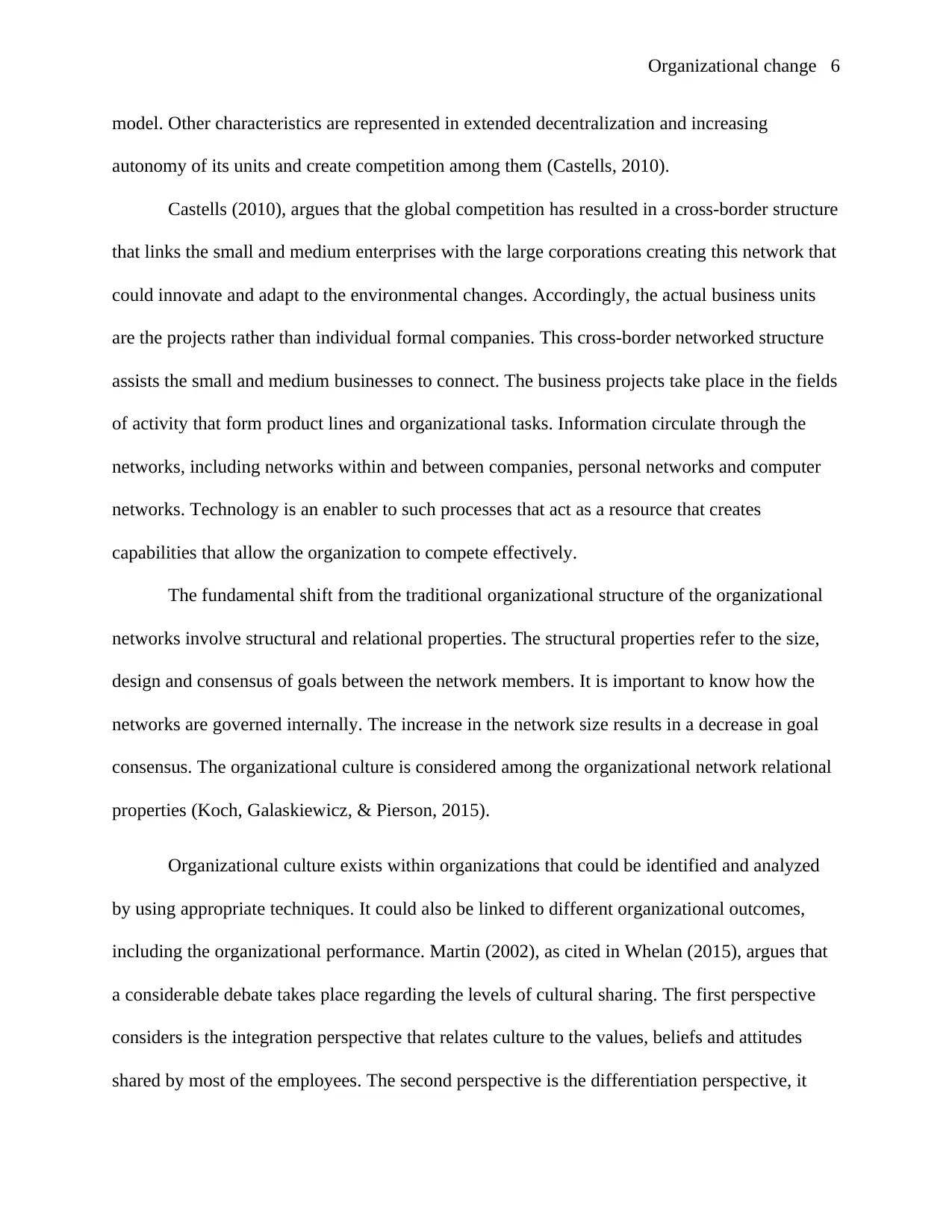
6Organizational change
model. Other characteristics are represented in extended decentralization and increasing
autonomy of its units and create competition among them (Castells, 2010).
Castells (2010), argues that the global competition has resulted in a cross-border structure
that links the small and medium enterprises with the large corporations creating this network that
could innovate and adapt to the environmental changes. Accordingly, the actual business units
are the projects rather than individual formal companies. This cross-border networked structure
assists the small and medium businesses to connect. The business projects take place in the fields
of activity that form product lines and organizational tasks. Information circulate through the
networks, including networks within and between companies, personal networks and computer
networks. Technology is an enabler to such processes that act as a resource that creates
capabilities that allow the organization to compete effectively.
The fundamental shift from the traditional organizational structure of the organizational
networks involve structural and relational properties. The structural properties refer to the size,
design and consensus of goals between the network members. It is important to know how the
networks are governed internally. The increase in the network size results in a decrease in goal
consensus. The organizational culture is considered among the organizational network relational
properties (Koch, Galaskiewicz, & Pierson, 2015).
Organizational culture exists within organizations that could be identified and analyzed
by using appropriate techniques. It could also be linked to different organizational outcomes,
including the organizational performance. Martin (2002), as cited in Whelan (2015), argues that
a considerable debate takes place regarding the levels of cultural sharing. The first perspective
considers is the integration perspective that relates culture to the values, beliefs and attitudes
shared by most of the employees. The second perspective is the differentiation perspective, it
model. Other characteristics are represented in extended decentralization and increasing
autonomy of its units and create competition among them (Castells, 2010).
Castells (2010), argues that the global competition has resulted in a cross-border structure
that links the small and medium enterprises with the large corporations creating this network that
could innovate and adapt to the environmental changes. Accordingly, the actual business units
are the projects rather than individual formal companies. This cross-border networked structure
assists the small and medium businesses to connect. The business projects take place in the fields
of activity that form product lines and organizational tasks. Information circulate through the
networks, including networks within and between companies, personal networks and computer
networks. Technology is an enabler to such processes that act as a resource that creates
capabilities that allow the organization to compete effectively.
The fundamental shift from the traditional organizational structure of the organizational
networks involve structural and relational properties. The structural properties refer to the size,
design and consensus of goals between the network members. It is important to know how the
networks are governed internally. The increase in the network size results in a decrease in goal
consensus. The organizational culture is considered among the organizational network relational
properties (Koch, Galaskiewicz, & Pierson, 2015).
Organizational culture exists within organizations that could be identified and analyzed
by using appropriate techniques. It could also be linked to different organizational outcomes,
including the organizational performance. Martin (2002), as cited in Whelan (2015), argues that
a considerable debate takes place regarding the levels of cultural sharing. The first perspective
considers is the integration perspective that relates culture to the values, beliefs and attitudes
shared by most of the employees. The second perspective is the differentiation perspective, it
⊘ This is a preview!⊘
Do you want full access?
Subscribe today to unlock all pages.

Trusted by 1+ million students worldwide
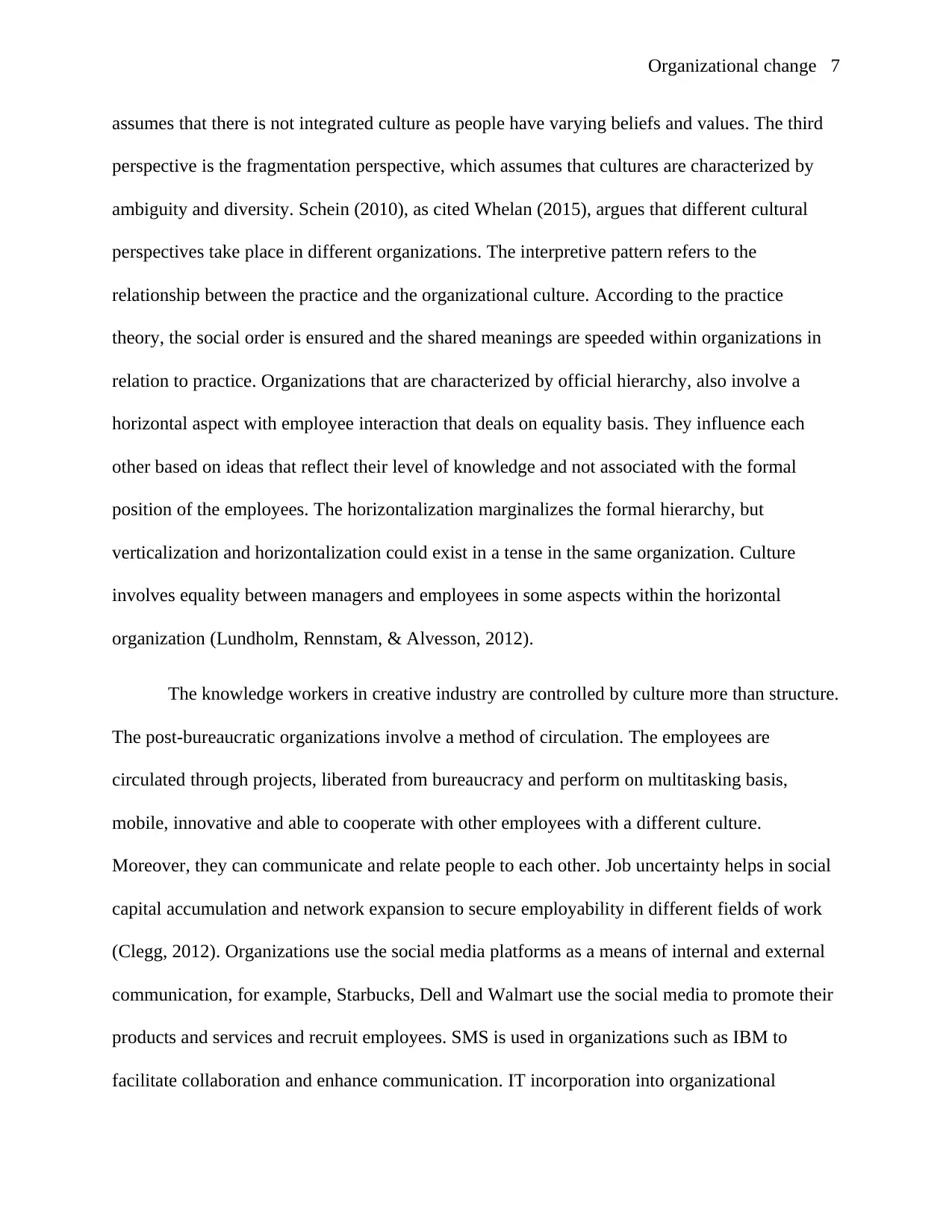
7Organizational change
assumes that there is not integrated culture as people have varying beliefs and values. The third
perspective is the fragmentation perspective, which assumes that cultures are characterized by
ambiguity and diversity. Schein (2010), as cited Whelan (2015), argues that different cultural
perspectives take place in different organizations. The interpretive pattern refers to the
relationship between the practice and the organizational culture. According to the practice
theory, the social order is ensured and the shared meanings are speeded within organizations in
relation to practice. Organizations that are characterized by official hierarchy, also involve a
horizontal aspect with employee interaction that deals on equality basis. They influence each
other based on ideas that reflect their level of knowledge and not associated with the formal
position of the employees. The horizontalization marginalizes the formal hierarchy, but
verticalization and horizontalization could exist in a tense in the same organization. Culture
involves equality between managers and employees in some aspects within the horizontal
organization (Lundholm, Rennstam, & Alvesson, 2012).
The knowledge workers in creative industry are controlled by culture more than structure.
The post-bureaucratic organizations involve a method of circulation. The employees are
circulated through projects, liberated from bureaucracy and perform on multitasking basis,
mobile, innovative and able to cooperate with other employees with a different culture.
Moreover, they can communicate and relate people to each other. Job uncertainty helps in social
capital accumulation and network expansion to secure employability in different fields of work
(Clegg, 2012). Organizations use the social media platforms as a means of internal and external
communication, for example, Starbucks, Dell and Walmart use the social media to promote their
products and services and recruit employees. SMS is used in organizations such as IBM to
facilitate collaboration and enhance communication. IT incorporation into organizational
assumes that there is not integrated culture as people have varying beliefs and values. The third
perspective is the fragmentation perspective, which assumes that cultures are characterized by
ambiguity and diversity. Schein (2010), as cited Whelan (2015), argues that different cultural
perspectives take place in different organizations. The interpretive pattern refers to the
relationship between the practice and the organizational culture. According to the practice
theory, the social order is ensured and the shared meanings are speeded within organizations in
relation to practice. Organizations that are characterized by official hierarchy, also involve a
horizontal aspect with employee interaction that deals on equality basis. They influence each
other based on ideas that reflect their level of knowledge and not associated with the formal
position of the employees. The horizontalization marginalizes the formal hierarchy, but
verticalization and horizontalization could exist in a tense in the same organization. Culture
involves equality between managers and employees in some aspects within the horizontal
organization (Lundholm, Rennstam, & Alvesson, 2012).
The knowledge workers in creative industry are controlled by culture more than structure.
The post-bureaucratic organizations involve a method of circulation. The employees are
circulated through projects, liberated from bureaucracy and perform on multitasking basis,
mobile, innovative and able to cooperate with other employees with a different culture.
Moreover, they can communicate and relate people to each other. Job uncertainty helps in social
capital accumulation and network expansion to secure employability in different fields of work
(Clegg, 2012). Organizations use the social media platforms as a means of internal and external
communication, for example, Starbucks, Dell and Walmart use the social media to promote their
products and services and recruit employees. SMS is used in organizations such as IBM to
facilitate collaboration and enhance communication. IT incorporation into organizational
Paraphrase This Document
Need a fresh take? Get an instant paraphrase of this document with our AI Paraphraser
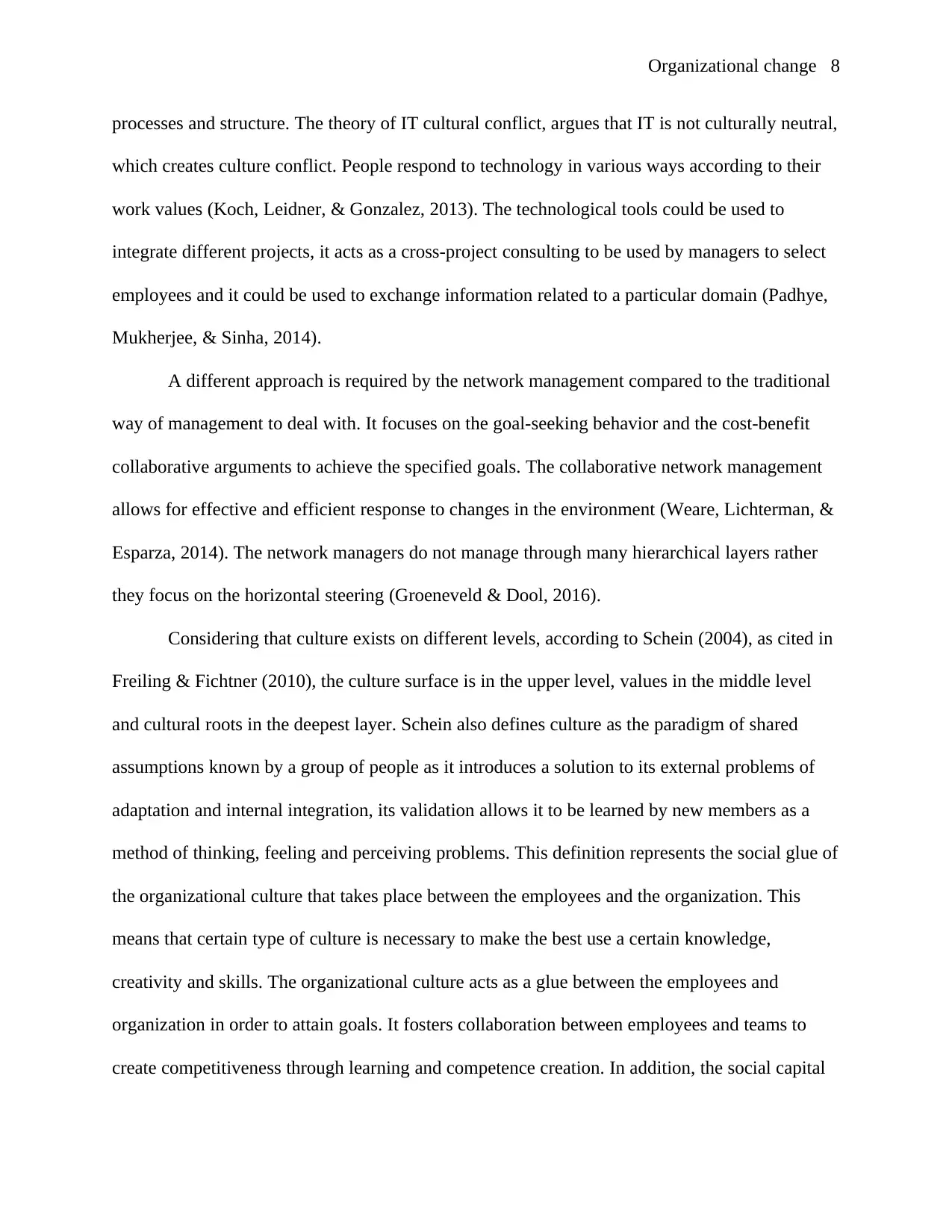
8Organizational change
processes and structure. The theory of IT cultural conflict, argues that IT is not culturally neutral,
which creates culture conflict. People respond to technology in various ways according to their
work values (Koch, Leidner, & Gonzalez, 2013). The technological tools could be used to
integrate different projects, it acts as a cross-project consulting to be used by managers to select
employees and it could be used to exchange information related to a particular domain (Padhye,
Mukherjee, & Sinha, 2014).
A different approach is required by the network management compared to the traditional
way of management to deal with. It focuses on the goal-seeking behavior and the cost-benefit
collaborative arguments to achieve the specified goals. The collaborative network management
allows for effective and efficient response to changes in the environment (Weare, Lichterman, &
Esparza, 2014). The network managers do not manage through many hierarchical layers rather
they focus on the horizontal steering (Groeneveld & Dool, 2016).
Considering that culture exists on different levels, according to Schein (2004), as cited in
Freiling & Fichtner (2010), the culture surface is in the upper level, values in the middle level
and cultural roots in the deepest layer. Schein also defines culture as the paradigm of shared
assumptions known by a group of people as it introduces a solution to its external problems of
adaptation and internal integration, its validation allows it to be learned by new members as a
method of thinking, feeling and perceiving problems. This definition represents the social glue of
the organizational culture that takes place between the employees and the organization. This
means that certain type of culture is necessary to make the best use a certain knowledge,
creativity and skills. The organizational culture acts as a glue between the employees and
organization in order to attain goals. It fosters collaboration between employees and teams to
create competitiveness through learning and competence creation. In addition, the social capital
processes and structure. The theory of IT cultural conflict, argues that IT is not culturally neutral,
which creates culture conflict. People respond to technology in various ways according to their
work values (Koch, Leidner, & Gonzalez, 2013). The technological tools could be used to
integrate different projects, it acts as a cross-project consulting to be used by managers to select
employees and it could be used to exchange information related to a particular domain (Padhye,
Mukherjee, & Sinha, 2014).
A different approach is required by the network management compared to the traditional
way of management to deal with. It focuses on the goal-seeking behavior and the cost-benefit
collaborative arguments to achieve the specified goals. The collaborative network management
allows for effective and efficient response to changes in the environment (Weare, Lichterman, &
Esparza, 2014). The network managers do not manage through many hierarchical layers rather
they focus on the horizontal steering (Groeneveld & Dool, 2016).
Considering that culture exists on different levels, according to Schein (2004), as cited in
Freiling & Fichtner (2010), the culture surface is in the upper level, values in the middle level
and cultural roots in the deepest layer. Schein also defines culture as the paradigm of shared
assumptions known by a group of people as it introduces a solution to its external problems of
adaptation and internal integration, its validation allows it to be learned by new members as a
method of thinking, feeling and perceiving problems. This definition represents the social glue of
the organizational culture that takes place between the employees and the organization. This
means that certain type of culture is necessary to make the best use a certain knowledge,
creativity and skills. The organizational culture acts as a glue between the employees and
organization in order to attain goals. It fosters collaboration between employees and teams to
create competitiveness through learning and competence creation. In addition, the social capital
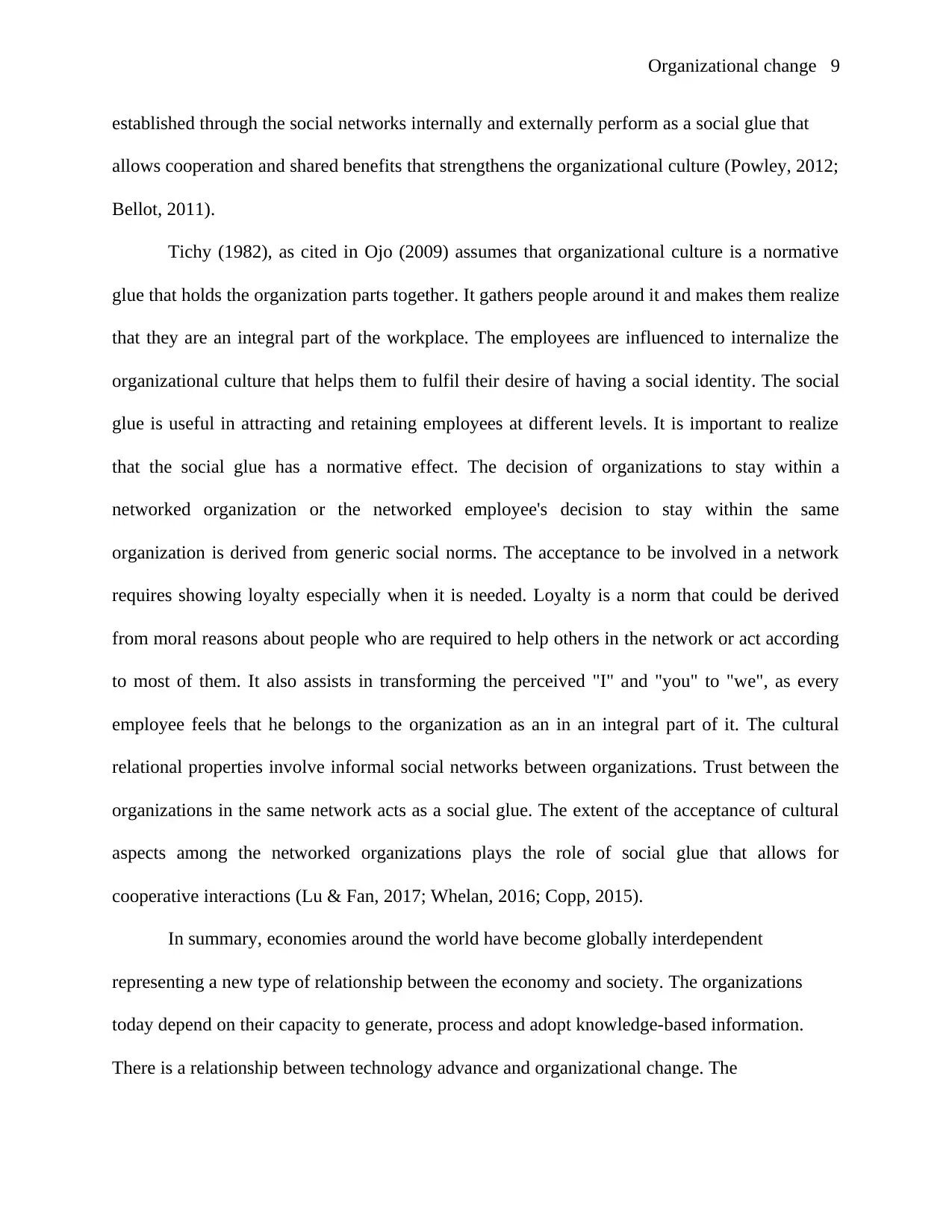
9Organizational change
established through the social networks internally and externally perform as a social glue that
allows cooperation and shared benefits that strengthens the organizational culture (Powley, 2012;
Bellot, 2011).
Tichy (1982), as cited in Ojo (2009) assumes that organizational culture is a normative
glue that holds the organization parts together. It gathers people around it and makes them realize
that they are an integral part of the workplace. The employees are influenced to internalize the
organizational culture that helps them to fulfil their desire of having a social identity. The social
glue is useful in attracting and retaining employees at different levels. It is important to realize
that the social glue has a normative effect. The decision of organizations to stay within a
networked organization or the networked employee's decision to stay within the same
organization is derived from generic social norms. The acceptance to be involved in a network
requires showing loyalty especially when it is needed. Loyalty is a norm that could be derived
from moral reasons about people who are required to help others in the network or act according
to most of them. It also assists in transforming the perceived "I" and "you" to "we", as every
employee feels that he belongs to the organization as an in an integral part of it. The cultural
relational properties involve informal social networks between organizations. Trust between the
organizations in the same network acts as a social glue. The extent of the acceptance of cultural
aspects among the networked organizations plays the role of social glue that allows for
cooperative interactions (Lu & Fan, 2017; Whelan, 2016; Copp, 2015).
In summary, economies around the world have become globally interdependent
representing a new type of relationship between the economy and society. The organizations
today depend on their capacity to generate, process and adopt knowledge-based information.
There is a relationship between technology advance and organizational change. The
established through the social networks internally and externally perform as a social glue that
allows cooperation and shared benefits that strengthens the organizational culture (Powley, 2012;
Bellot, 2011).
Tichy (1982), as cited in Ojo (2009) assumes that organizational culture is a normative
glue that holds the organization parts together. It gathers people around it and makes them realize
that they are an integral part of the workplace. The employees are influenced to internalize the
organizational culture that helps them to fulfil their desire of having a social identity. The social
glue is useful in attracting and retaining employees at different levels. It is important to realize
that the social glue has a normative effect. The decision of organizations to stay within a
networked organization or the networked employee's decision to stay within the same
organization is derived from generic social norms. The acceptance to be involved in a network
requires showing loyalty especially when it is needed. Loyalty is a norm that could be derived
from moral reasons about people who are required to help others in the network or act according
to most of them. It also assists in transforming the perceived "I" and "you" to "we", as every
employee feels that he belongs to the organization as an in an integral part of it. The cultural
relational properties involve informal social networks between organizations. Trust between the
organizations in the same network acts as a social glue. The extent of the acceptance of cultural
aspects among the networked organizations plays the role of social glue that allows for
cooperative interactions (Lu & Fan, 2017; Whelan, 2016; Copp, 2015).
In summary, economies around the world have become globally interdependent
representing a new type of relationship between the economy and society. The organizations
today depend on their capacity to generate, process and adopt knowledge-based information.
There is a relationship between technology advance and organizational change. The
⊘ This is a preview!⊘
Do you want full access?
Subscribe today to unlock all pages.

Trusted by 1+ million students worldwide
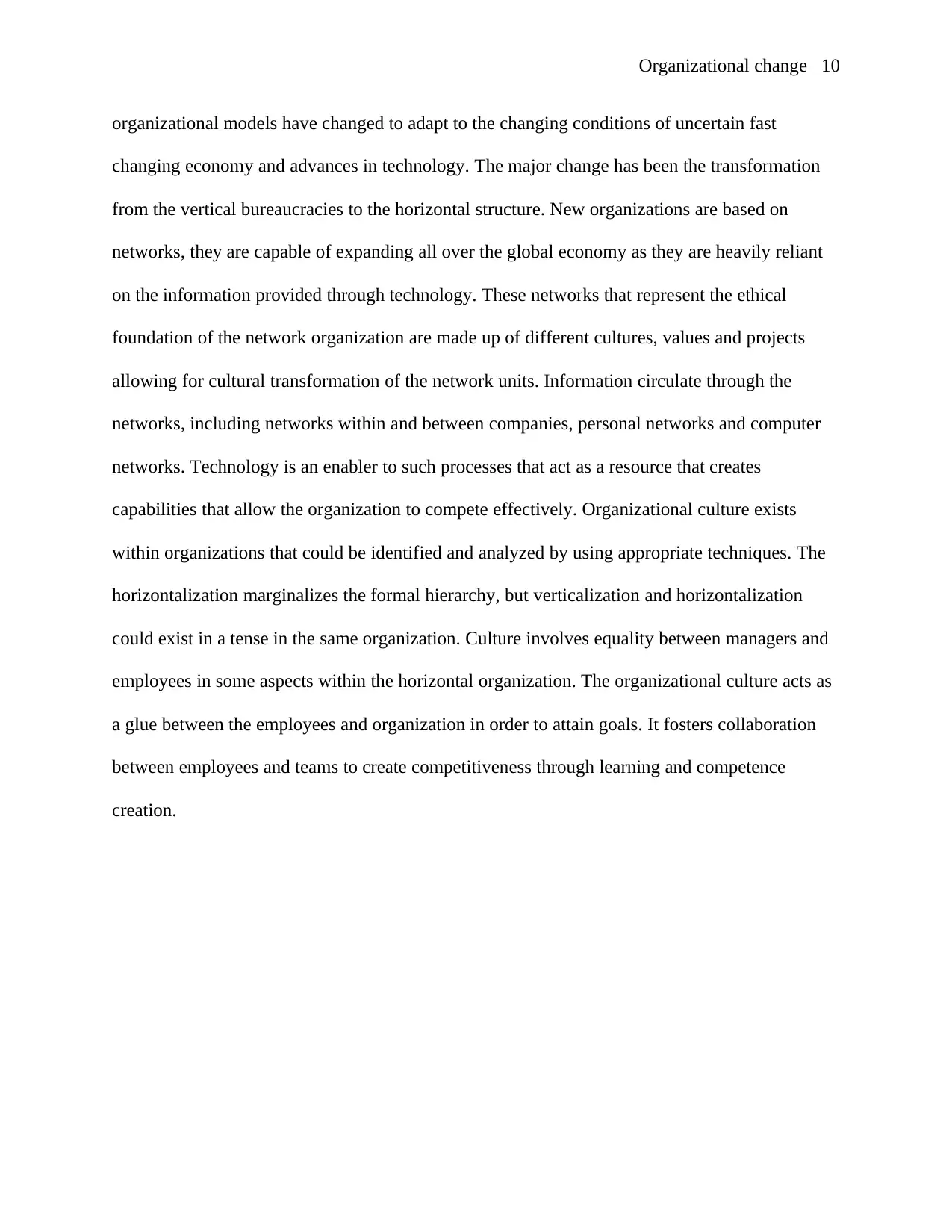
10Organizational change
organizational models have changed to adapt to the changing conditions of uncertain fast
changing economy and advances in technology. The major change has been the transformation
from the vertical bureaucracies to the horizontal structure. New organizations are based on
networks, they are capable of expanding all over the global economy as they are heavily reliant
on the information provided through technology. These networks that represent the ethical
foundation of the network organization are made up of different cultures, values and projects
allowing for cultural transformation of the network units. Information circulate through the
networks, including networks within and between companies, personal networks and computer
networks. Technology is an enabler to such processes that act as a resource that creates
capabilities that allow the organization to compete effectively. Organizational culture exists
within organizations that could be identified and analyzed by using appropriate techniques. The
horizontalization marginalizes the formal hierarchy, but verticalization and horizontalization
could exist in a tense in the same organization. Culture involves equality between managers and
employees in some aspects within the horizontal organization. The organizational culture acts as
a glue between the employees and organization in order to attain goals. It fosters collaboration
between employees and teams to create competitiveness through learning and competence
creation.
organizational models have changed to adapt to the changing conditions of uncertain fast
changing economy and advances in technology. The major change has been the transformation
from the vertical bureaucracies to the horizontal structure. New organizations are based on
networks, they are capable of expanding all over the global economy as they are heavily reliant
on the information provided through technology. These networks that represent the ethical
foundation of the network organization are made up of different cultures, values and projects
allowing for cultural transformation of the network units. Information circulate through the
networks, including networks within and between companies, personal networks and computer
networks. Technology is an enabler to such processes that act as a resource that creates
capabilities that allow the organization to compete effectively. Organizational culture exists
within organizations that could be identified and analyzed by using appropriate techniques. The
horizontalization marginalizes the formal hierarchy, but verticalization and horizontalization
could exist in a tense in the same organization. Culture involves equality between managers and
employees in some aspects within the horizontal organization. The organizational culture acts as
a glue between the employees and organization in order to attain goals. It fosters collaboration
between employees and teams to create competitiveness through learning and competence
creation.
Paraphrase This Document
Need a fresh take? Get an instant paraphrase of this document with our AI Paraphraser
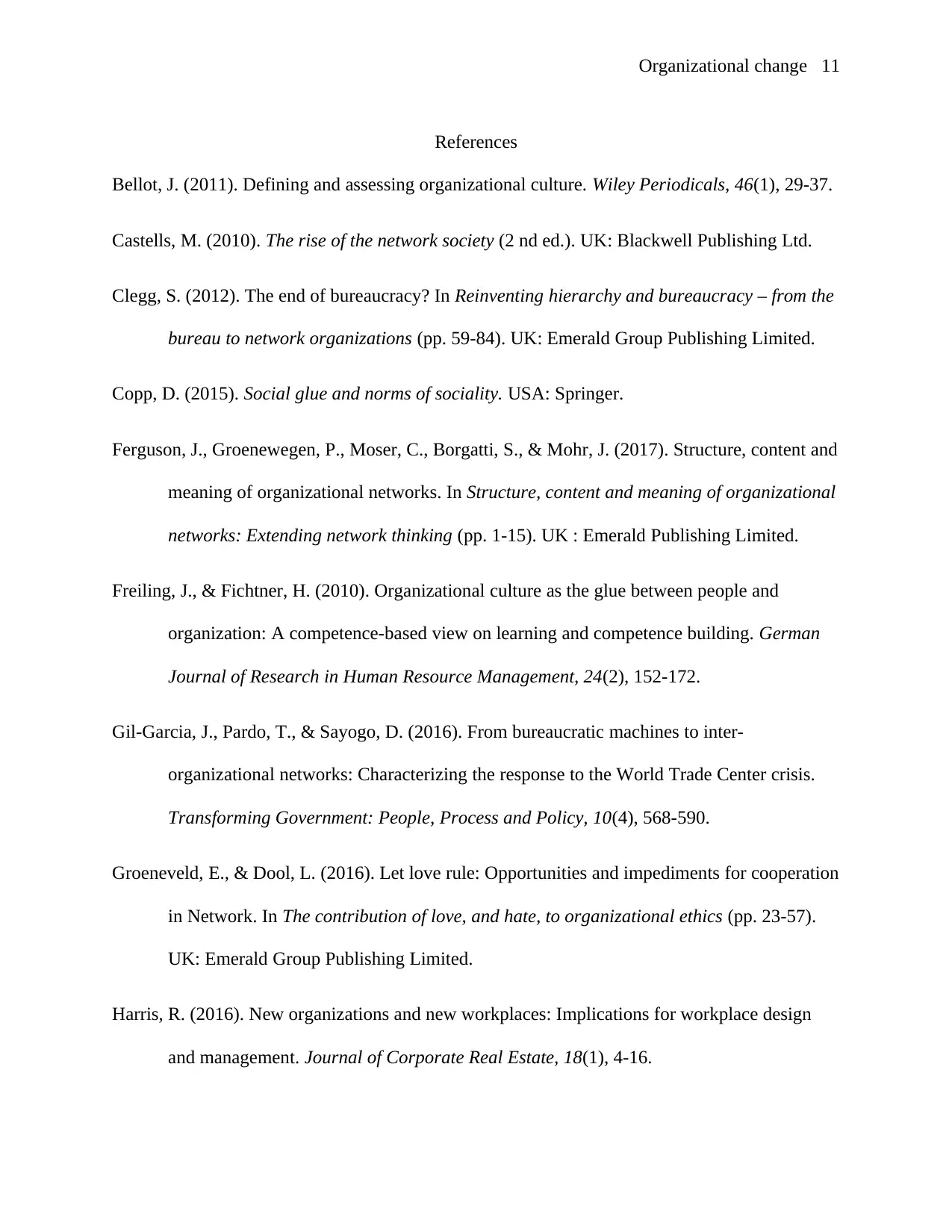
11Organizational change
References
Bellot, J. (2011). Defining and assessing organizational culture. Wiley Periodicals, 46(1), 29-37.
Castells, M. (2010). The rise of the network society (2 nd ed.). UK: Blackwell Publishing Ltd.
Clegg, S. (2012). The end of bureaucracy? In Reinventing hierarchy and bureaucracy – from the
bureau to network organizations (pp. 59-84). UK: Emerald Group Publishing Limited.
Copp, D. (2015). Social glue and norms of sociality. USA: Springer.
Ferguson, J., Groenewegen, P., Moser, C., Borgatti, S., & Mohr, J. (2017). Structure, content and
meaning of organizational networks. In Structure, content and meaning of organizational
networks: Extending network thinking (pp. 1-15). UK : Emerald Publishing Limited.
Freiling, J., & Fichtner, H. (2010). Organizational culture as the glue between people and
organization: A competence-based view on learning and competence building. German
Journal of Research in Human Resource Management, 24(2), 152-172.
Gil-Garcia, J., Pardo, T., & Sayogo, D. (2016). From bureaucratic machines to inter-
organizational networks: Characterizing the response to the World Trade Center crisis.
Transforming Government: People, Process and Policy, 10(4), 568-590.
Groeneveld, E., & Dool, L. (2016). Let love rule: Opportunities and impediments for cooperation
in Network. In The contribution of love, and hate, to organizational ethics (pp. 23-57).
UK: Emerald Group Publishing Limited.
Harris, R. (2016). New organizations and new workplaces: Implications for workplace design
and management. Journal of Corporate Real Estate, 18(1), 4-16.
References
Bellot, J. (2011). Defining and assessing organizational culture. Wiley Periodicals, 46(1), 29-37.
Castells, M. (2010). The rise of the network society (2 nd ed.). UK: Blackwell Publishing Ltd.
Clegg, S. (2012). The end of bureaucracy? In Reinventing hierarchy and bureaucracy – from the
bureau to network organizations (pp. 59-84). UK: Emerald Group Publishing Limited.
Copp, D. (2015). Social glue and norms of sociality. USA: Springer.
Ferguson, J., Groenewegen, P., Moser, C., Borgatti, S., & Mohr, J. (2017). Structure, content and
meaning of organizational networks. In Structure, content and meaning of organizational
networks: Extending network thinking (pp. 1-15). UK : Emerald Publishing Limited.
Freiling, J., & Fichtner, H. (2010). Organizational culture as the glue between people and
organization: A competence-based view on learning and competence building. German
Journal of Research in Human Resource Management, 24(2), 152-172.
Gil-Garcia, J., Pardo, T., & Sayogo, D. (2016). From bureaucratic machines to inter-
organizational networks: Characterizing the response to the World Trade Center crisis.
Transforming Government: People, Process and Policy, 10(4), 568-590.
Groeneveld, E., & Dool, L. (2016). Let love rule: Opportunities and impediments for cooperation
in Network. In The contribution of love, and hate, to organizational ethics (pp. 23-57).
UK: Emerald Group Publishing Limited.
Harris, R. (2016). New organizations and new workplaces: Implications for workplace design
and management. Journal of Corporate Real Estate, 18(1), 4-16.
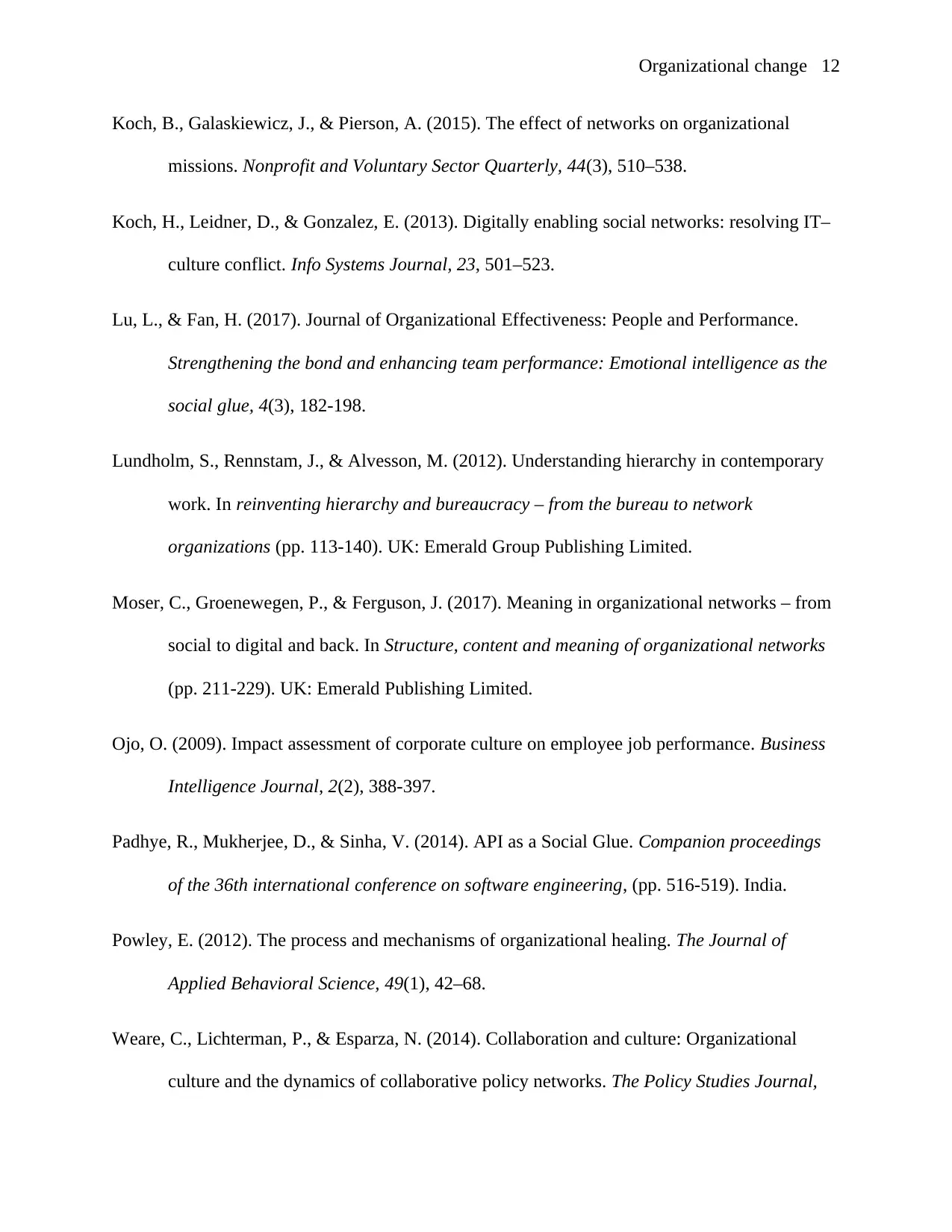
12Organizational change
Koch, B., Galaskiewicz, J., & Pierson, A. (2015). The effect of networks on organizational
missions. Nonprofit and Voluntary Sector Quarterly, 44(3), 510–538.
Koch, H., Leidner, D., & Gonzalez, E. (2013). Digitally enabling social networks: resolving IT–
culture conflict. Info Systems Journal, 23, 501–523.
Lu, L., & Fan, H. (2017). Journal of Organizational Effectiveness: People and Performance.
Strengthening the bond and enhancing team performance: Emotional intelligence as the
social glue, 4(3), 182-198.
Lundholm, S., Rennstam, J., & Alvesson, M. (2012). Understanding hierarchy in contemporary
work. In reinventing hierarchy and bureaucracy – from the bureau to network
organizations (pp. 113-140). UK: Emerald Group Publishing Limited.
Moser, C., Groenewegen, P., & Ferguson, J. (2017). Meaning in organizational networks – from
social to digital and back. In Structure, content and meaning of organizational networks
(pp. 211-229). UK: Emerald Publishing Limited.
Ojo, O. (2009). Impact assessment of corporate culture on employee job performance. Business
Intelligence Journal, 2(2), 388-397.
Padhye, R., Mukherjee, D., & Sinha, V. (2014). API as a Social Glue. Companion proceedings
of the 36th international conference on software engineering, (pp. 516-519). India.
Powley, E. (2012). The process and mechanisms of organizational healing. The Journal of
Applied Behavioral Science, 49(1), 42–68.
Weare, C., Lichterman, P., & Esparza, N. (2014). Collaboration and culture: Organizational
culture and the dynamics of collaborative policy networks. The Policy Studies Journal,
Koch, B., Galaskiewicz, J., & Pierson, A. (2015). The effect of networks on organizational
missions. Nonprofit and Voluntary Sector Quarterly, 44(3), 510–538.
Koch, H., Leidner, D., & Gonzalez, E. (2013). Digitally enabling social networks: resolving IT–
culture conflict. Info Systems Journal, 23, 501–523.
Lu, L., & Fan, H. (2017). Journal of Organizational Effectiveness: People and Performance.
Strengthening the bond and enhancing team performance: Emotional intelligence as the
social glue, 4(3), 182-198.
Lundholm, S., Rennstam, J., & Alvesson, M. (2012). Understanding hierarchy in contemporary
work. In reinventing hierarchy and bureaucracy – from the bureau to network
organizations (pp. 113-140). UK: Emerald Group Publishing Limited.
Moser, C., Groenewegen, P., & Ferguson, J. (2017). Meaning in organizational networks – from
social to digital and back. In Structure, content and meaning of organizational networks
(pp. 211-229). UK: Emerald Publishing Limited.
Ojo, O. (2009). Impact assessment of corporate culture on employee job performance. Business
Intelligence Journal, 2(2), 388-397.
Padhye, R., Mukherjee, D., & Sinha, V. (2014). API as a Social Glue. Companion proceedings
of the 36th international conference on software engineering, (pp. 516-519). India.
Powley, E. (2012). The process and mechanisms of organizational healing. The Journal of
Applied Behavioral Science, 49(1), 42–68.
Weare, C., Lichterman, P., & Esparza, N. (2014). Collaboration and culture: Organizational
culture and the dynamics of collaborative policy networks. The Policy Studies Journal,
⊘ This is a preview!⊘
Do you want full access?
Subscribe today to unlock all pages.

Trusted by 1+ million students worldwide
1 out of 13
Related Documents
Your All-in-One AI-Powered Toolkit for Academic Success.
+13062052269
info@desklib.com
Available 24*7 on WhatsApp / Email
![[object Object]](/_next/static/media/star-bottom.7253800d.svg)
Unlock your academic potential
Copyright © 2020–2025 A2Z Services. All Rights Reserved. Developed and managed by ZUCOL.



